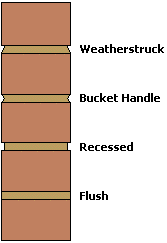Introduction:
Bricklaying is a trade in its own right, separate from paving, drainage and groundworks. It would be easy to fill an entire website dealing solely with that one subject, but this site is concerned only with bricklaying techniques for items as manhole covers, gully gratings and simple walls. What follows is a very basic introduction to bricks and bricklaying; other sites, such as the Brick Development Association can provide more detailed coverage for those wishing to learn more about cants, cavities and queen closers.
Types of bricks
Facing Bricks
There are literally thousands of different bricks, but they can be broken down into a handful of basic types. The vast majority are made from clay and are kiln-fired. Quality, durable bricks with an attractive appearance for external use above ground.

Wirecut
The clay is continuously extruded to a required size and shape and then cut into individual bricks by means of a wire, much like a cheese is cut by cheesewire. Thousands of variations in colour and texture. Usually the cheapest facings available as the manufacturing process is highly automated.
Typical wirecut bricks shown opposite



Stock
The clay is wetted to a so-called "soft mud" and then moulded to shape, before being allowed to dry prior to firing in the kiln. Much of the process is automated. Tend to be slightly irregular in shape. Usually a bit more expensive than wirecuts.
Typical Stock bricks shown opposite



Handmade
Usually made on a bench, in a mould, much as described above for a stock brick. Because the clay isn't firmly compacted by machine, each brick normally has distinctive creasing known as a 'smile'. Very desirable, and the most expensive of the facings, but well worth it on prestige jobs.
Typical Handmade bricks shown opposite
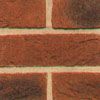
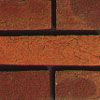

Fletton
Also known as 'London Bricks'. A unique facing brick manufactured from the Lower Oxford clay found only in SE England. This clay contains coal traces, which burn during firing, reducing the amount of fuel needed for the kiln, which not only keeps down costs but also produces some interesting effects in the bricks themselves.
Typical Fletton bricks shown opposite



Commons
A cheap 'fill' brick, designed to be utilitarian rather than attractive. Having said that, some have a charm of their own and are perfectly fine for smaller jobs.
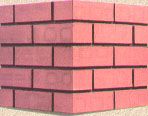
Engineering
The workhorses of the brick family. Tough, strong, hard-wearing but not usually very pretty. They have excellent resistance to frost and to water, making them ideal for groundworks, sewer works and retaining walls. You pay for the performance.


Concrete or Calcium Silicate
Popular in areas where good brick-making clay is scarce. Some are, quite frankly, bloody awful, but others may be split-faced or have a pitched face to give an impression of being something other than boring concrete. Cheap and cheerful sums them up.


Reclaimed
Salvaged bricks. Bricks rescued from old buildings and cleaned up, of a fashion. You really have to know what you're looking for to make sure you get decent quality rather than any old dross, so buy through a reputable merchant. Their charm is undeniable, when laid by a good brickie, but there can be a high level of wastage. Many will be the old Imperial sizes (2 " or 3")which are incompatible with the modern metric bricks (65mm). Don't be fooled into thinking that because they have been rescued from some old doss house that they will be cheap - cleaning them up and sorting them is a labour intensive task and they can cost twice the price of a quality facing or a 'reproduction' reclaimed.
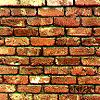

Specials
Any brick that isn't a rectangle. Just to confuse non-bricklayers, there are "standard specials", such as bullnoses, cants and radials, and "special specials" such as cills and quoins. These specials allow fantastic design possibilities and make brickwork the most aesthetically pleasing medium for building.
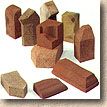
Other Walling Products
As well as bricks, there are all sorts of concrete blocks that can be used to build walls and other structures. Some are decorative; some are utilitarian; some are insulating; some are for use below ground...whatever the application, there'll be a concrete block that's suitable.
For hard-landscape wall building, the decorative concrete blocks are the most popular type of walling block. Many of these attempt to replicate natural stone, to varying degrees of success. They tend to be produced in differing lengths and depths to further enhance the look of coursed walling stone, with 'jumper blocks' spanning 2 or more courses.
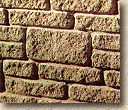
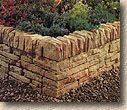
Some walling blocks aren't mortared together in the usual way, but use a special cement-based adhesive to 'glue' the blocks and copings together. These products are primarily aimed at garden construction and the DIY market, and can only be used for walls up to around 1 metre in height.
Plain concrete blocks can be used when a wall is to be rendered and/or painted; trench blocks are a good and cost-saving choice for foundation courses and 'Thermalite' blocks can be easily shaped with a Surform to all sorts of weird and wonderful forms.
Classification of Durability
Bricks are categorised according to the degree of frost resistance they exhibit, with a further categorisation of their soluble salt content.
Class
Resistance
Uses
F
Frost Resistant
Suitable for all building work, including situations where they may be repeatedly saturated, such as retainer walls or below ground level.
M
Moderate Resistance
Fairly durable when used in non-saturated conditions, ie, between the dpc and the eaves of a house
O
Not Resistant
Only suitable for internal use; should not be used in landscaping projects
Table 1 Frost resistance of Bricks
Soluble salt content is categorised as L - Low, or N - Normal. Soluble salt content may have some effect on the incidence of efflorescence on brickwork, although soluble salts within the mortar and in groundwater may also affect its appearance.
The Frost rating is combined with the Salt Content rating to give 6 possible categories for all clay bricks: FL and FN, ML and MN, or OL and ON.
For most landscaping works, only bricks from class FL or FN are suitable, although some ML/MN bricks may be suitable for brickwork more than 150mm below ground level.
Brick Format
Modern metric bricks in Britain are sized to create a modular format. The standard brick size is 215 × 102.5 × 65mm (face × bed × end), so, with a standard 10-12mm wide joint, this gives a working size of 225mm × 75mm.
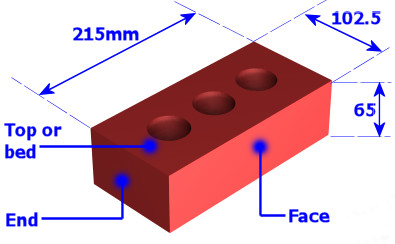
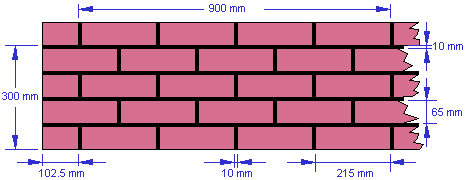
As can be seen in the diagram opposite, 4 courses of bricks including the bedding joints gives a total depth of 300mm and 4 bricks in a line gives a width of 900mm including the perpends (vertical joints).
Using stretcher bond, there are 60 bricks per square metre in a single skin wall.

Bricks are laid in one of three ways, as illustrated above. Stretcher is the most common, but they may be interleaved with courses of headers in 225mm walls (see Bond Patterns ). Bricks "on edge" are usually laid so as a wall capping or to make up brickwork to a specific height when fixing ironwork ( manhole covers , gratings, etc.)
Bricklaying
Bricklaying is a skilled trade that takes many years to master. Bricks are laid in courses, on a bed of mortar, with a taut string line used as a guide to line and level. The horizontal joint is the "bed joint"; the vertical joints are "perpends".
The ends of walls are built first, with the level and verticality of the bricks checked repeatedly as the corners/ends are raised. The gauging is also checked, to ensure that 4 courses measures 300mm. The ends are typically "Racked Back", as illustrated opposite, which allows successive courses to be laid direct to the string line without having to continually check the work with a spirit level.
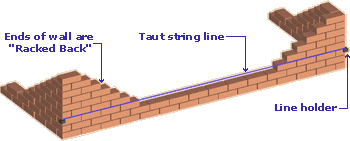
The bed mortar is laid out and shaped to accept the bricks. The end of the brick to be laid is buttered with mortar and then shoved against the preceding brick, squeezing the mortar to a width of 10mm. The brick is tapped down to level with the heel of the trowel, any surplus mortar extruded from the bed or the perpend is scraped off with the trowel, and then the process repeated with the next brick. At the completion of each course, the guide line is moved up to the next course.
Although stretcher bond has been used for most of the wall illustrations on this web site, there are over 30 different brickwork bonds that can be used. Seven of the most popular bonds are depicted on the Walls page.
With solid or perforated bricks, the orientation of the brick doesn't matter, but with frogged bricks, the frog should always be laid uppermost. This ensures that the loading of the wall is evenly spread across its width, rather than being concentrated onto the edges, and that there are no voids within the brickwork that could be weak spots.
Frogged or perforated brickwork should always be covered over if left unfinished for any period when rain is about, to prevent the frogs or perforations filling with water which would make a mess of the bed mortar when bricklaying resumes.
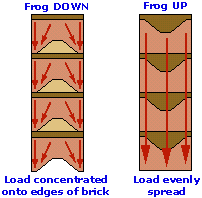
Mortar Coverage
1 m³ of mortar will lay approx 1800 bricks (1300-2100 depending on frog etc.) or 1200 nr blocks @ 450x225x100mm. 1800 standard bricks = 30m² and each cubic metre of mortar weighs around 2.1 Tonnes, therefore each square metre of single skin brickwork requires approximately 70 Kg of mortar.
1 tonne of lime mortar will lay approx 1000 bricks (700-1200) or 600 blocks @ 450x225x100
Pointing Styles
Pointing ensures the bed joints and perpends are properly filled with mortar. Pointing is usually undertaken an hour or so after the bricks have been laid, long enough for the mortar to stiffen but not so long that it has become unworkable. The unpointed joints can be topped up with fresh mortar if they are not quite full, before tooling to the required style.
The most common pointing styles are shown opposite. The Weatherstruck and Flush profiles are formed with the blade of a trowel. The Bucket Handle profile is formed with a semi-circular section jointing bar, and the Recess profile is created with a joint raker.
Tooled joints, notably the Weatherstruck and Bucket Handle, offer better resistance to rain penetration.
